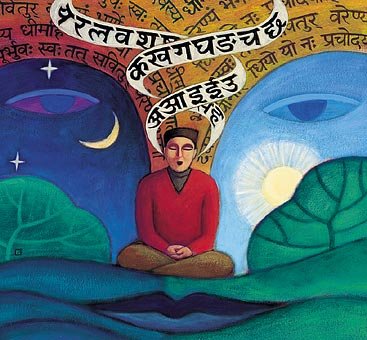 NEW DELHI: Disparaged as being commercially unviable and dubbed ‘a dead language,’ Sanskrit is staging a quiet resurgence both at home and among NRIs.
NEW DELHI: Disparaged as being commercially unviable and dubbed ‘a dead language,’ Sanskrit is staging a quiet resurgence both at home and among NRIs.
Statistics illustrate the point: Twitter has a community of more than 200 Sanskrit users who like to post on current events in the language; the Union Budget 2014 being the latest. Spoken Sanskrit classes in the capital include IT professionals; enrolment has doubled over two years. In USA, memberships at Sanskrit camps have shot up times 20 over the past decade-and-a-half, sources say. Fittingly while the nation-wide Sanskrit Week celebrations ended on Thursday, Manjul Bhargava, winner of ‘Nobel Prize in Maths’, announced himself to be an unabashed admirer of Sanskrit poetry.
Truth is the devavani, speech of the divine, is no longer the exclusive preserve of the pandit and the pujari. Several young urban, educated, and, even global Indians are in love with the language.
Meet Satyasekhar Chakka from Hyderabad, a chemical engineer pursuing a PhD in nanotechnology from IIT Kanpur. He had taken lessons in Sanskrit in school as his third language. He says a “literary love that transmuted into a keen desire to explore the history of Indian technology” accessible in old texts prompted him to take up further study.
Satyasekhar represents a phenomenon of the growing number of engineers and IT professionals discovering and responding to an urge to study Sanskrit, says Laxminarasimhan, who helps create lessons on behalf of Sanskrit Promotion Foundation for CBSE. An electronics engineer, Laxminarasimhan is a part of the Samskrita Bharati movement “for the development of Samskrita language, literature and mankind”, begun in Bangalore in 1981. He gives out free lessons in spoken Sanskrit on behalf of the trust and completed his MA in the subject from Kerala State Open University in 2012.
About 40-45% of Laxminarasimhan’s classes comprise IT workers and 30-35% are women homemakers. The remaining are retirees. The older generation shows a marked interest in the Bhagvad Geeta. NRIs are the most dedicated learners, he says.
California-based biotechnologist Govinda Yelagalavadi, 56, is one such learner. His wife and college-going daughter Varija too speak and teach Sanskrit, often at family camps held in cities like Boston and Sacramento. “The first such camp in 2000 had only 35 attendees, today there are five such events organized annually with a total attendance of about 630 people,” Govinda says. “For us, it’s a means to reconnect with our roots and history.”
In India, it is a different story. Most of those who study Sanskrit in universities are driven by family tradition. Some feel a need to acquire knowledge in theology and Hindu philosophical systems. Fewer get hooked to the subject’s linguistic and literary aspects. Those who want to study the old texts join the gurukuls and universities directly. “Some four-five students each year make the Indian Administrative Service. If you study whole-heartedly, there is no dearth of work or life opportunities,” says C Upender Rao, chairperson of Special Centre for Sanskrit Studies at JNU.
Even so, there’s more evidence of NRI interest in Sanskrit. Back in 2009, only 16 students opted for Sanskrit as foreign language course run by Samskrita Bharati in the United States. Now there are 126.
In India, membership at 3,000 centres of the trust has almost doubled over two years from one lakh in 2012 to nearly two lakhs, says Dr P Nandakumar, trust general secretary. “This revival has been largely due to our teaching style which is informal and focuses on speaking the language,” he explains.
The trust is among four-five such initiatives all over India, informs economist and Sanskrit enthusiast Bibek Debroy. He cites 2001 census figures of 14,135 — much higher from the 6,106 in 1981 — to attest that there has been a renewed interest in the language which, he says, is limited to the educated middle classes who live in cities or have even migrated abroad.
He holds bad teaching based on rote learning as one of the important reasons for this decline. The real revamp, he says, has to take place at the school level and “finding good teachers as well as using the online medium is of key importance. Twitter interactions can be a basis for growth of the language. Highlights of the 2014 Budget speech were tweeted in Sanskrit”.
“There is a very narrow niche of people who inhabit the world of Sanskrit scholarship. They write and publish in the language and go to conferences, and then there is the rest of the world. The two don’t meet. The challenge is to get the rest of the world interested in Sanskrit,” Debroy says.





